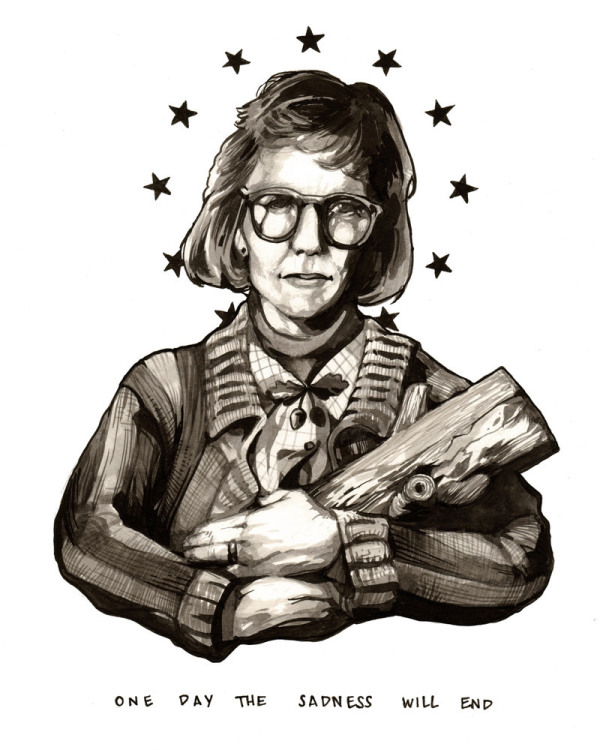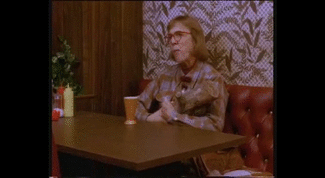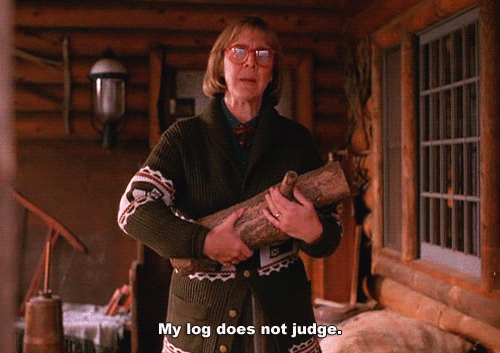Artowrk by JJUSTINE DEVINE
EDITOR’S NOTE: This interview originally posted on September 28th, 2015. In advance of Sunday night’s long-anticipated reactivation of David Lynch’s Twin Peaks, we present this reprise edition.
EDITOR’S NOTE 4/25/16: Just found out the sad and shocking news that Katherine passed away today. In tribute, we present a reprise edition of this very in-depth interview we did with her last October in advance of her talk at the Pennsylvania Academy Of The Arts, which was part of PAFA’s David Lynch retrospective, The Unified Field. She was very generous with her time — this was probably the most in-depth interview she ever did — and flattered that we would devote so much time and space to the discussion of her life and career. As you might expect of the Log Lady, she went through the interview with a fine tooth comb checking facts and sent back two extensive lists of corrections. I know she was very pleased with how it turned out. The resulting interview is a wide-open window onto Katherine’s fascinating life and career. She will be missed. Good night, Miss Coulson, wherever you are.
 BY JONATHAN VALANIA Catherine Coulson, aka Twin Peaks‘ resident Log Lady, will be giving a sold-out talk
BY JONATHAN VALANIA Catherine Coulson, aka Twin Peaks‘ resident Log Lady, will be giving a sold-out talk at the Pennsylvania Academy of the Fine Arts on Saturday about all things David Lynch, with whom she has collaborated creatively since production commenced on Eraserhead back in 1971. Like everyone else in the cast and crew, from star down to cameraman, she was paid $25 a week. When money ran low — as it often did over the course of the six years it took to complete the film — her weekly salary was halved to $12.50. But true to his word, Lynch cut everyone in on the proceeds when Eraserhead became a cult smash. “Eraserhead helped put my daughter through college,” Coulson told me a few weeks ago when we spoke on the phone. She still gets a check every year. Back in the lean years, Lynch and Coulson brainstormed a character called The Log Girl — kooky, clairvoyant, and always cradling heavy lumber. She would have to wait more than a decade to bring the character to life as cast member of Twin Peaks. By then, The Log Girl had blossomed into The Log Lady — a role she will be reprising next year when the Twin Peaks franchise reactivates after going dark for 25 years, with Lynch and Mark Frost back at the helm. As you’ve no doubt heard by now, that gum we all like is finally back in style.
DISCUSSED: Doing experimental theater naked in Haight-Ashbury in the Summer Of Love; meeting David Lynch @ The American Film Institute; being assistant director of Eraserhead and earning $12.50 a week for six years; being married to Jack Nance, aka Henry from Eraserhead; doing Jack Nance’s Eraserhead hair style; The Unified Field; The Amputee; Bertolt Brecht; Hamburger Hamlet; Jean Genet; Anne Bancroft; Ellen Burstyn; Mel Brooks; The Elephant Man; Pennsylvania Academy of The Fine Arts; Jack Fisk; Sissy Spacek; why David Lynch always wore three ties while making Eraserhead; the Lady In The Radiator; Bob’s Big Boy; Agent Cooper; Major Briggs; the prevalence of Log Lady tattoos on the internet; Roseanne Barr; Russ Tamblyn; Richard Beymer; Piper Laurie; Mark Frost; Kyle MacLachlan; Fire Walk With Me; the return of Twin Peaks.
PHAWKER: Tell me about your life before David Lynch comes into the picture. Where are you from?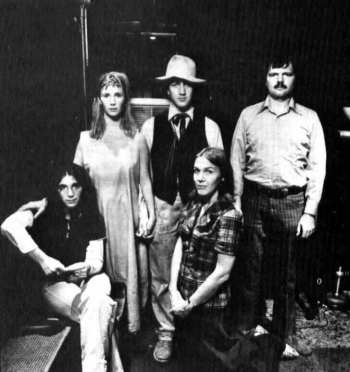
CATHERINE COULSON: Oh, gee. I don’t even remember life before meeting David. I was a young woman then. I met him at the American Film Institute in Beverly Hills, right after he moved there from Philadelphia. He was a student at the American Film Institute, and he heard about our theater company, which was in San Francisco, where I had been working. I was married to Jack Nance, who went on to play Pete Martell on Twin Peaks, and Henry in Eraserhead. David heard about the two of us in a workshop that we did at the American Film Institute teaching acting to director fellows. He asked Jack to come over and work a little bit on his script for Eraserhead. He cast Jack, and then he asked me if I would be a nurse in Eraserhead. He had a kind of outline. I had graduated from Scripps College in Claremont, California, and then moved to San Francisco for grad school. Met Jack Nance, got married. Came down to Beverly Hills on tour with our theater, and that’s when I met David. I really spent the next four or five years of my life working on Eraserhead, because Jack was playing Henry. I kept waiting to shoot my scene, but by the time we got to it, it seemed like overkill to do the scene where the nurse gives Henry and Mary the baby. I was helping to raise money for the film, by that time. David decided not to shoot it, which I’ll always regret, because it would’ve been fun to be in it. I am in an outtake — which unfortunately, I think is lost — where I’m strapped to a bed tied with battery cables. It’s in the room next door to Henry’s. During this time, working together on the film, we became very good friends and collaborators. I always felt like I was the handmaiden to genius. I did everything from styling Jack’s hair to making grilled sandwiches for the crew. We also made The Amputee, is that in the show, do you know? Have you seen it?
PHAWKER: No, do tell.
CATHERINE COULSON: Oh, OK. It’s an interesting piece, When the AFI executives wanted to test two kinds of videotape ‘stock’ for use in the students’ projects they asked Fred Elmes to shoot something twice on the two different kinds of tape. (I think they were expecting a color chart or grey scale). David heard about it and he and Fred decided to shoot a scene which David wrote about a woman writing a letter. I played the woman — an amputee — and David played the doctor who tended to her bandaged stumps. We shot it twice on two video tape ‘stocks’ and used voice over only. The short was called The Amputee and when it was screened by the AFI executives for the two video tape companies, I remember one of them saying, “LYNCH. LYNCH HAD SOMETHING TO DO WITH THIS!”
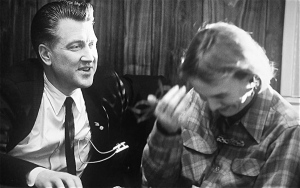 I guess they weren’t prepared for blood spurting out of an amputated limb.We just called it a simple little love story, Eraserhead. But it seemed really normal to us, at the time. When people would ask what Eraserhead was about, we would just say it’s a simple love story. So that’s pretty much my history. I was an actor, and I worked for David, and then I went on and worked in film as a result of working on Eraserhead. I did camera work, and then I went back to acting full-time, and that’s what I’m still doing. We’re going do Twin Peaks again, so I’m excited about that.
I guess they weren’t prepared for blood spurting out of an amputated limb.We just called it a simple little love story, Eraserhead. But it seemed really normal to us, at the time. When people would ask what Eraserhead was about, we would just say it’s a simple love story. So that’s pretty much my history. I was an actor, and I worked for David, and then I went on and worked in film as a result of working on Eraserhead. I did camera work, and then I went back to acting full-time, and that’s what I’m still doing. We’re going do Twin Peaks again, so I’m excited about that.
PHAWKER: We all are. Let’s back up. If you were doing theater in San Francisco, in what must have been the late sixties, I’m guessing you’d done a lot of avant-garde stuff.
CATHERINE COULSON: Yes, we did. We did a lot of protest theatre, a lot of underground theatre. We did a lot of Brecht, and Genet. It was sort of the era of taking your clothes off for the sake of art. [laughs] We actually did a play called Tom Paine, which was by Tom O’Horgon, which was an American Revolution play. We took that on tour to Los Angeles, and performed that alternating with an organization called El Tiatro Campesino, which was a bi-lingual progressive theater theater.
It was during that time that Jack and I decided to go ahead and make a move to Los Angeles. It was shortly after we moved there that we met David through our theater director, David Lindeman, who was also a fellow at the American Film Institute. He introduced us both to David, who wanted to cast his film. That’s really how we got started in our friendship, by being cast in the film. He never auditions actors, he just talks to you. He asked me to time a scene with Henry in the bedroom. He was building the sets at the time, with his brother. We timed the scene, and I ran the stopwatch. I think that impressed David, that I could run a stopwatch. We really just started shooting, and I got to do everything, from holding the boom for Alan Splet to helping Herb Cardwell, who was one of the cameramen. It was really my film school, that time at the AFI.
I also worked at the AFI in the directing workshop for women, which I helped produce. There’s a program for women who were already in film, and wanted to direct. It was people like Anne Bancroft and Ellen Burstyn; they were given the opportunity to direct short films. I did that while working on Eraserhead. It was during that time that David gave me the drawing of “The Family,” which is in the exhibit at the Pennsylvania Academy of the Fine Arts. I had it in my kitchen ever since. I loaned it to the museum for this exhibit, so I’m eager to go back and see it. I always wanted one of those “From the collection of…” you know, those little cards? I finally got my fantasy fulfilled.
PHAWKER: Is AFI where David met Anne Bancroft, and is that how she wound up in The Elephant Man?
CATHERINE COULSON: I think the reason David met Anne Bancroft is that another producing fellow at the AFI was working for Mel Brooks. His name was Stuart Cornfeld. He showed Mel Brooks Eraserhead, and Mel really liked it, and asked David to direct Elephant Man. He hired two writers, and I think he asked David to come on board with them. They wrote the script. I know, I was working on a movie with Anne Bancroft at Fox called Fatso, with Dom DeLuise.
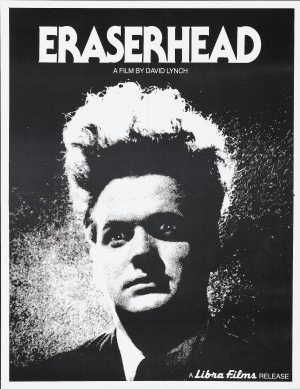 PHAWKER: PHAWKER: You did Jack Nance’s hair for Eraserhead. Tell me about how the hairstyle came about and how you wound up creating it. You basically just combed it straight up, yes?
PHAWKER: PHAWKER: You did Jack Nance’s hair for Eraserhead. Tell me about how the hairstyle came about and how you wound up creating it. You basically just combed it straight up, yes?
CATHERINE COULSON: We had to keep it cut to the exact same length. First we had a barber cut it, and then it was too expensive to keep doing that, because the film took a while to shoot. I started cutting it, and then backcombing and spraying it. It was pretty hard on the marriage, as you can imagine. Keeping his hair like that for four years. He used to wear a lot of hats. My family hardly knew him without that haircut. But David designed it. It was his idea that Henry would look like that. I just maintained the style over the years. It would grow out, and I would re-cut it. Before we shot, we always checked the hair to make sure it matched shots that were sometimes taken months prior. I think there’s a picture somewhere on the old box set of Eraserhead of me doing Jack’s hair.
PHAWKER: The irony is, it was kind of ahead of its time. When punk came along in the 80’s, many young people were wearing it.
CATHERINE COULSON: It was really ahead of its time. That’s what we used to jokingly say, “Do you think people will ever wear their hair like this?” And then people started wearing their hair like that. It was pretty amazing. But David was always ahead of his time.
PHAWKER: Give me the time frame on this. How long did it take until Eraserhead was finished.
CATHERINE COULSON: We showed it at Filmex, which was the film festival in LA at the time, in ‘77. At that time, after that is when Libra Films and Ben Barenholtz picked it up for midnight distribution. But we shot the film from about ’71 or ’72. It took about four years, because we had to stop and raise money. That’s when I stepped in and helped different people to chip in $200 here, $500 there. Then, David got together with Mary Fisk, who is Jack Fisk’s sister. Jack was the one who got David to the Pennsylvania Academy of the Fine Arts. She really helped get it going, and got it into Filmex. She took over the post-production nudging. We did have a screening of it in the American Film Institute, the original version that was a lot longer. Everybody was very quiet afterwards. It was after that when David thought he needed to make it shorter. We didn’t have any money to cut negatives, so he just cut entire scenes. That was what happened to my scene where I’m tied to the bed with battery cables [pictured, below], that’s probably in a landfill somewhere.
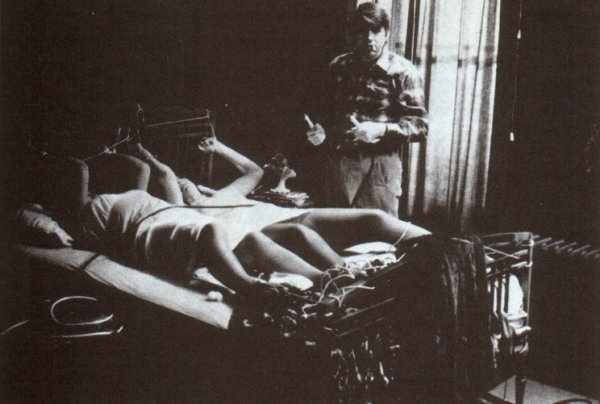
“A scene cut from Eraserhood: Henry hears noises down the hall and investigates. He opens one of the doors just a crack and sees Gill Dennis with a strange device, and V. Phipps-Wilson and Catherine Coulson trussed-ip in bed. Henry shuts the door fast.” SOURCE: CINEFANTASTIQUE
PHAWKER: When you first encountered this project, did it strike you as being as strange and bizarre as it was, or were you so accustomed to this material that it seemed quite ordinary?
CATHERINE COULSON: When I say it was ordinary, it was just that David was so regular. He was a regular guy, and really sweet. He did wear three ties and a Panama hat that had some holes in it.
PHAWKER: What do you mean he wore three ties?
CATHERINE COULSON: He wore three ties. They were his lucky ties.
PHAWKER: Around his neck?
CATHERINE COULSON: Yeah, they were like regular ties. And this Panama hat that had developed a few holes in it over time. He was such a regular guy. He told the story minimally, as it was really kind of an outline. I don’t really remember a script, per se. At the time, it was just a simple little love story, where this couple meets and makes a baby. I was just hired to play the nurse who gives him the baby at the hospital, a scene we never shot. It seemed all very normal. It was also film school for me. I didn’t know anything about making films. It was 35 millimeter, and I learned a tremendous amount from David while we were making the movie. We were all kind of learning together.
PHAWKER: One last question on Eraserhead: Do you have an interpretation of what the movie means, or do you just sit back and let surrealism and dream logic 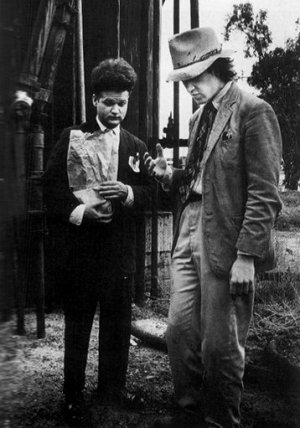 roll over you? Or do you have a more literal take of exactly what’s going on in the film? Especially towards the end.
roll over you? Or do you have a more literal take of exactly what’s going on in the film? Especially towards the end.
CATHERINE COULSON: It’s hard for me to put my finger on exactly what the movie is about, except that it is a love story, and Henry finding himself through the Lady in the Radiator, I believe. David himself is always reluctant to interpret his work so I, too, am reluctant to interpret his work. I feel like its such a visual, aural experience to sit and watch the movie in a movie theater with a big projector and great sound. Any interpretation of it kind of limits the audience’s reaction.
PHAWKER: I read somewhere that he went back and sort of cut everyone that worked for years on the film into some of the residuals from…
CATHERINE COULSON: He did that immediately when we were finished shooting. We sat down at Bob’s Big Boy or Hamburger Hamlet, and wrote out what points we would each get if it ever made any money, which honestly, I don’t think any of us knew that it would be so successful. We had no idea. David always paid the crew, he always paid us. We all made the same amount of money: $25 a week. At some point, the money was running low, so we went to $12.50 a week. He always believed in paying us out of his money from the AFI. Then we started raising more money to finish it. After that, when there was a rough cut, it was the late seventies. He said “I wanted to make sure you all get a part of this if it ever makes any money.” So, we each got a percentage. I got a really nice percentage that, to this day, this was long before ancillary rights or DVDs or anything. To this day, I get an Eraserhead check every year. It helped put my daughter through college. She went to Parsons School of Design partly on Eraserhead money. I mean, it’s pretty amazing. What goes around comes around. David’s always been generous in that way. He’s also generous in sharing the credits. It’s his vision, his movie, but he always thanks the people who worked on it.
PHAWKER: Were you credited as Assistant To The Director?
CATHERINE COULSON: I was. That was sort of a thing that we made a choice, and I didn’t know much at the time about what to say I was. That was what we decided to call me, Assistant To The Director. Actually, I was the camera assistant as well, which I really wanted because I had learned so much from Herb and especially Fred. But I think back on it now, and I look at the movie, “Mr. Nance’s hair by:” because I had to keep doing his hair for so many years. Really, we all did everything. It was truly our film school. I filled drawers with vanilla pudding and peas to put the humidifier in. I don’t think that scene is in the movie now. I helped get umbilical cords, things like that. Once David asked me to find out from Universal Studio’s special effects department, to call them and ask them how to fill a room full of mush. It was things like that we all did. I was just one of the people. There were about five of us at the end who really helped make David’s vision happen. We really bonded over that in our twenties, and have stayed friends ever since. That’s when he dreamed up the Log Lady. He was always drawing during that time. One day, he drew the Lady in the Radiator. That was when he kind of got what he would put in the film for Henry. That was a little drawing, I have to find it.
PHAWKER: I just watched Eraserhead recently, and it was only this last time that I realized — I thought she had sideburns, but I guess it’s some kind of growth on the side of her face? Can you explain that.
CATHERINE COULSON: She just had full cheeks. He made that makeup.
PHAWKER: You just cued us into the Log Lady entering into the story. What’s the origin?
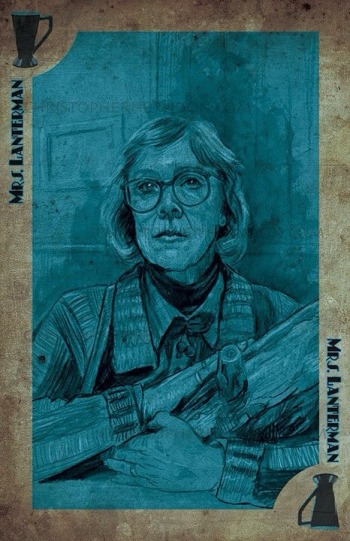 CATHERINE COULSON: We were shooting at night at the American Film Institute at the stables, because during the day, the gardeners used them. We had to have it quiet, so we would shoot all night. I would be taking notes, and I often wore plaid, pleated skirts and sweaters, and I had these glasses that I would wear at night. David was very into wood, because his father had worked for the U.S. Forest Service. I think he was a research botanist. I’m not positive. He got this idea. He said, “Someday, Catherine, I’d like to do a TV series with you in it. You’d be this girl who takes a log around to different experts. We learn about the log, the wood, and we learn about the experts. It was going be called “I’ll Test My Log With Every Branch of Knowledge.” I would go to, like, a dentist. We’d put on one of those little blue towels on the log, and the dentist would probe the rings, and we’d learn about dental health, as well as about the log. It was always going to be a Ponderosa pine, which his dad had done his thesis on.
CATHERINE COULSON: We were shooting at night at the American Film Institute at the stables, because during the day, the gardeners used them. We had to have it quiet, so we would shoot all night. I would be taking notes, and I often wore plaid, pleated skirts and sweaters, and I had these glasses that I would wear at night. David was very into wood, because his father had worked for the U.S. Forest Service. I think he was a research botanist. I’m not positive. He got this idea. He said, “Someday, Catherine, I’d like to do a TV series with you in it. You’d be this girl who takes a log around to different experts. We learn about the log, the wood, and we learn about the experts. It was going be called “I’ll Test My Log With Every Branch of Knowledge.” I would go to, like, a dentist. We’d put on one of those little blue towels on the log, and the dentist would probe the rings, and we’d learn about dental health, as well as about the log. It was always going to be a Ponderosa pine, which his dad had done his thesis on.
This idea kind of cooked up, and we called her the Log Girl. A few years later, probably around ’88 or ’89, David called up, and said “Are you ready to do the Log Girl?” I said, “Well, you know, she’s not really a girl any more.” So we called her the Log Lady. He told me about this idea for a series that he and Mark Frost had gotten. He’d have to do a pilot for the American Broadcast Corporation. I said, “Do you mean ABC is going do a pilot!?” I went up to Seattle, and we shot this first scene of me flipping a light switch in the pilot. “Who’s that lady?” “That’s the Log Lady.” That kind of took off in the imagination of the press, I think. That’s how the Log Lady started. But it really started with “I’ll Test My Log With Every Branch of Knowledge.” Then, as the show progressed, David and I would talk about her backstory, and fill in that she had a husband who died in a forest fire, and that she would be a sort of soothsayer, etc. The part grew as we talked it through. Before I would shoot a scene, he would call and we would talk about it. It’s a real wonderful collaboration, figuring out about the Log Girl as she matured, and learned more and more about wood. Now, I feel like a real expert on wood, actually, having done this for so many years. I really know a lot about bark beetles, and I know a lot about ancient forests. Tree stands and stuff. I planted a lot of trees for people with AIDS in the ’80s. It’s really taken me in a whole new direction.
PHAWKER: I’m looking at the description of your event at PAFA. It says that you’re going to talk about your three favorite episodes?
CATHERINE COULSON: Yeah, that’s the plan. I had to pick three episodes. We’re going to do that.
PHAWKER: You wanna tell me which ones, and why? Or would you rather save that for the event?
CATHERINE COULSON: What do you think? I have to go look at my email. I know one of them is the famous tea party scene, where Agent Cooper and the guys come to my cabin. I don’t remember the exact episode number, but one of them is that. Another one is an episode where I spit pitch gum. The gum theme is pretty strong in Twin Peaks. I think they use that as a teaser about the new series coming out in 2016. ‘The kind of gum you like is coming back in style.’ There’s been a lot of press about that kind of gum you like. I think it was pitch gum, which you break off of a pine tree and chew. I spit really far. I was really proud of that, that I could spit so far. Another episode that has a scene in it, with Don Davis, who has unfortunately died since then. He was Major Briggs, and it was about shiny objects. I think there might be one where my character may have been abducted by aliens. I had an odd tattoo on my leg that David designed. I since then have seen that tattoo on people’s bodies. It’s most peculiar to see what was once on my leg on somebody’s neck.
PHAWKER: How would you describe this tattoo?
CATHERINE COULSON: It was two little peaks. It was very abstract. David drew it on my leg, and kept it on there for the show. Somebody just told me there’s a whole page of Log Lady tattoos on the Internet. I looked at it, and my daughter was telling me there was this guy on there who had a really hairy leg, with a picture of me on it, that was on Instagram. She wrote him and said, “That’s my mom.” It’s kind of odd that people tattoo another person’s likeness. I guess they’re fond of it as well.
PHAWKER: I’m Googling this right now, people do have you tattooed on their arms.
CATHERINE COULSON: I don’t really want to know all the body parts that people have me tattooed on.
PHAWKER: Tell me about your experience when the show was airing, and when it became a phenomenon. Were you surprised at how huge it had become?
CATHERINE COULSON: I think we all were surprised. I had no idea what impact it would have. We just were making a television show, and we had a big screening at the Director’s Guild for the pilot. That night, ABC told David they were ordering 13 more episodes. We were all like, ‘Wow. I wonder if this is going to change anything.’ Then, we started shooting it, and once the pilot aired and the press picked up on it, it really did become a phenomenon really quickly. I found out that I, in fact, really needed to dress well and be 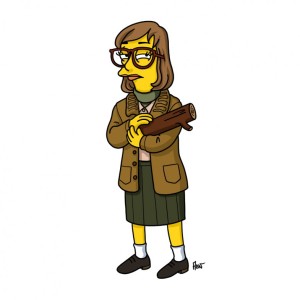 well groomed when I left the house, because people would stop me everywhere. One time, our little family was driving somewhere. We stopped at a coffee shop, and there was USA Today in the newsstands. In the upper right-hand corner, they always have a little photo, and it was a picture of me as the Log Lady. I was like, “Wow. This is really happening.” It was one of those things. We would start to go to affiliate dinners for the network. I remember once pulling up in our old Volvo. All these flashbulbs went off, and it was like, “What is going on?” My husband Marc said, “I think this might be for you.” I got out of the car, and there were all these people taking pictures. Roseanne Barr walked by, and screamed ‘It’s the Log Lady!’ It was one of those moments where I went, ‘I’m going have to be careful.’ I wasn’t allowed to just blurt out anything anymore. I had a certain responsibility to the log, really, and to David. It became this phenomenon, where we all went to affiliate things. I remember staying at the Waldorf Astoria, and being told I could order the large bowl of berries for breakfast. I was like, “Really!?” Going from making $12.50 a week on Eraserhead, to that, was really kind of fun. And much appreciated. We all got to really be friends with each other. The young actors in their twenties, and the older actors mentored the younger ones. I got to be really good friends with Russ Tamblyn and Rich Beymer, Piper Laurie. We had a good time together.
well groomed when I left the house, because people would stop me everywhere. One time, our little family was driving somewhere. We stopped at a coffee shop, and there was USA Today in the newsstands. In the upper right-hand corner, they always have a little photo, and it was a picture of me as the Log Lady. I was like, “Wow. This is really happening.” It was one of those things. We would start to go to affiliate dinners for the network. I remember once pulling up in our old Volvo. All these flashbulbs went off, and it was like, “What is going on?” My husband Marc said, “I think this might be for you.” I got out of the car, and there were all these people taking pictures. Roseanne Barr walked by, and screamed ‘It’s the Log Lady!’ It was one of those moments where I went, ‘I’m going have to be careful.’ I wasn’t allowed to just blurt out anything anymore. I had a certain responsibility to the log, really, and to David. It became this phenomenon, where we all went to affiliate things. I remember staying at the Waldorf Astoria, and being told I could order the large bowl of berries for breakfast. I was like, “Really!?” Going from making $12.50 a week on Eraserhead, to that, was really kind of fun. And much appreciated. We all got to really be friends with each other. The young actors in their twenties, and the older actors mentored the younger ones. I got to be really good friends with Russ Tamblyn and Rich Beymer, Piper Laurie. We had a good time together.
PHAWKER: You mention these people that were in a lot of movies in the sixties, and a lot of low-budget underground stuff. Did David see the film work that they did?
CATHERINE COULSON: No, he didn’t. He just interviewed people and then cast them. There wasn’t a lot of film with these people, they were actors in the theater. He doesn’t go to the theater very much, if at all, which is what I do now mostly for a living. He doesn’t come to them, but he saw the actors themselves and met them and cast them in Eraserhead.
PHAWKER: At the height of Twin Peaks, how clued in were you to what exactly was going on, or where the story lines were going to? Or was that a mystery to everybody while you guys were working on it?
CATHERINE COULSON: At the beginning, we all knew the story. We got whole scripts. As it became popular, and more and more people wanted to know what was going to happen, we started just getting scenes that we were in. We weren’t getting whole scripts. We were pretty much kept in the dark for our own safety. Not because we would blab, but because we didn’t want to have to answer questions.
PHAWKER:By the end of the first season, David was sort of busy with other projects, and let others take over along with Mark Frost. Very infamously, the public turned on the show. I’ve read also that a number of the actors — like Kyle MacLachlan and some of the younger female actors — felt abandoned by David, and by Mark Frost, and were reluctant to appear in Fire Walk With Me. I’m wondering what your thoughts were on that.
CATHERINE COULSON: I did not feel betrayed by Mark and David at all. The Log Lady was an important character in the story, but sort of an ancillary character. It didn’t affect me. I didn’t feel that way. I was happy to be in Fire Walk With Me. I can’t really speak for anyone else. I don’t remember that being an issue. I just remember that I was happy to be working in the show in the second season, and I did some episodes that David was in, and some that he directed. It was all the same big sand box that we’d all been in. When we did Fire Walk With Me, we did a couple of scenes that weren’t in the movie, but are now out on Blu-ray, along with Twin Peaks. After we finished shooting the show, it got picked up for cable on Bravo Network, and David wrote an introduction for each of the shows. We filmed for one very long day in like, 1993. David had written these amazing introductions to each episode, and I recorded those as the Log Lady. Those were added to the shows ever since, except for the ones that are on Netflix right now. They didn’t put them on, I don’t know why. I am sad that they’re not on there. But they are on the Blu-ray that just came out.
PHAWKER: Do you have the actual log prop that you used for the filming?
CATHERINE COULSON: I have the log. It’s in a secure, undisclosed location. I often say it’s in a secure location with a humidifier going at all times, because it has dried over the years. It’s a little lighter, I must say. That’s a good thing.
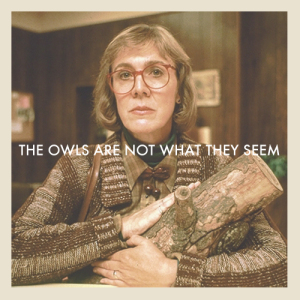 PHAWKER: How much did it weigh when you were filming?
PHAWKER: How much did it weigh when you were filming?
CATHERINE COULSON: It was pretty heavy, because it was still losing sap. We like to say that no tree’s lives were lost. It was just a log from the tree, but the tree still was living. We didn’t kill a tree to get the log.
PHAWKER: No trees were hurt in the making of this film.
CATHERINE COULSON: No, and that’s very important that people know that.
PHAWKER: Jumping ahead. Over the years, you become a beloved cult figure, especially among the superfans. You make public appearances; you go to the conventions and talk to people. I’m sure people have been asking you all along, “Will there ever be anymore Twin Peaks?” And now it’s finally happening.
CATHERINE COULSON: David said for a while, there are still stories to tell. But he never really articulated when or what. Then, a week ago, he called me from Paris, where he’s working on some lithography, and asked me if I could do the next batch of Twin Peaks that would air in 2016. I said I would be delighted to, and I asked him what I could say to people, and he said, you can say this: ‘Details to follow, and don’t play in the street.’ That was it. We chatted for a little bit about it, but I can’t say any more than ‘Details to follow, don’t play in the street.’
PHAWKER: To bring this back to The Unified Field exhibit at PAFA, how familiar are you with his paintings?
CATHERINE COULSON: David’s visual art is such an important part of what he does, as a filmmaker and television maker. To have this exhibit of The Unified Field at PAFA, is pretty exciting that it coincides with that. I’m going to come to Philadelphia, as you know, on the 29th of November, and see the exhibit, and see the drawing that I loaned, and do this talk on Twin Peaks, how he works as a filmmaker. He’s going to direct all nine episodes of the new series. He really works as a visual artist. That’s why sometimes in the script, the printed page wasn’t as important as his visual image of what it was going look like. He would sometimes stand up on a ladder, and look at us, and move us around. It was mostly more about his vision, as opposed to his printed word. Although he and Mark are writing all of the scripts now.
PHAWKER: Do you wanna talk about what you’re going to say on Saturday, or what your event’s going be like?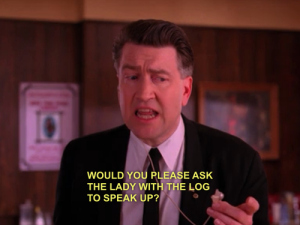
CATHERINE COULSON: I think the idea of it is that I am going to comment on … let me get the thing that they wrote, because I think I helped them write it. I can tell you what I’m doing. I know that I’m going to be showing these three episodes, and talking about it. Hold on a second, here.
PHAWKER: [reading] ‘Catherine Coulson, a.k.a. the Log Lady from David Lynch’s cult classic Twin Peaks, visits PAFA for great night of movies, munchies and midnight tours. Coulson’s unique perspective on how Lynch’s visual arts practices informed direct production onset, creates a new context for the series, and will screen her three favorite episodes, and respond to your observations and questions, followed by a midnight tour of David Lynch: The Unified Field. Admission includes free popcorn and two complimentary drinks.’ Sounds like a good deal.
CATHERINE COULSON: I think the free popcorn’s a big draw. Hopefully I’ll be able to entertain them with stories, but I do think that David shoots with the eye of a visual artist and that is why this exhibit ties in so well with Twin Peaks. His whole thing was that he was a visual artist, and he wanted those paintings to move. I think that’s really true, and that’s why he’s such a powerful filmmaker. They are, truly, moving pictures.

